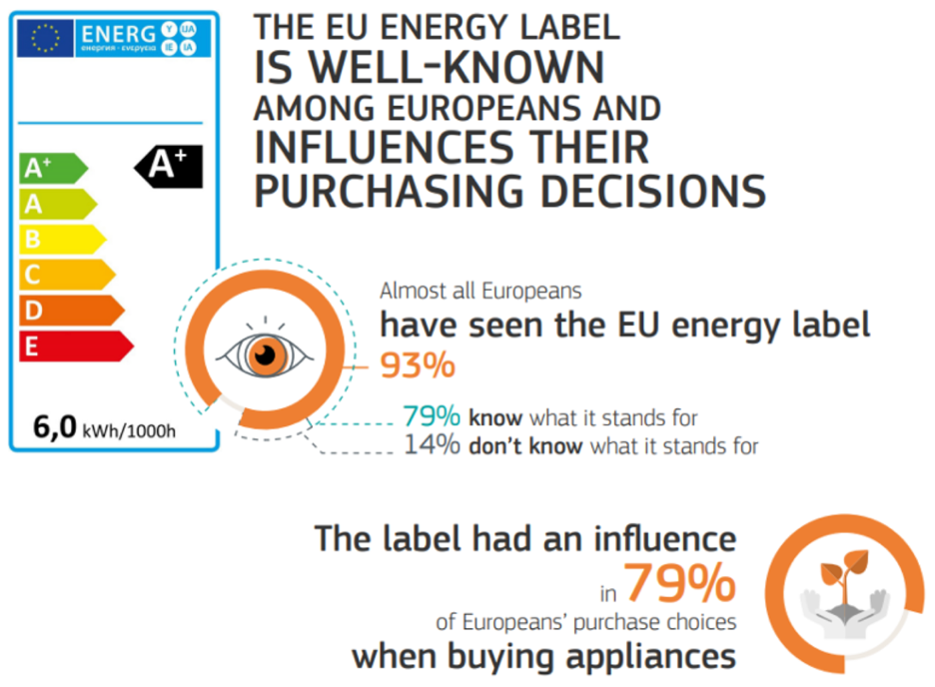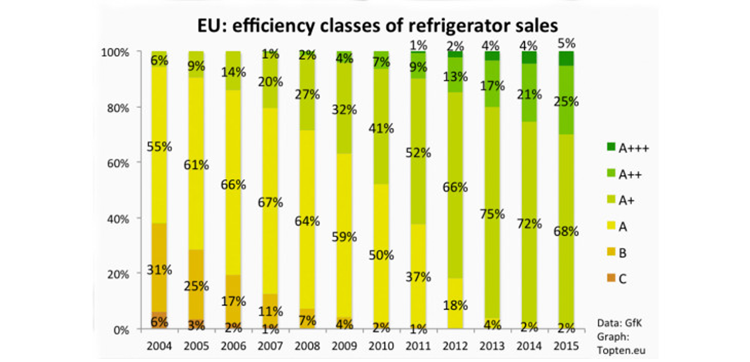
Evolving the EU Energy Label: Shaping Consumer Choices and Market Transformation
Summary: Energy labels are critical information tools that empower consumers to make more energy-efficient purchasing decisions. Created in the late 1990’s, the EU energy label is one of the most established, trusted and effective appliance energy labels in the world, influencing nearly 80% of all purchase decisions in the EU. The label also pushes the EU appliance market toward higher-efficiency products by compelling manufacturers to eliminate inefficient models and continually improve the efficiency of their products. This case study identifies key decisions that helped shape the EU energy label into one of the most successful labeling programs today and summarizes the program’s impact to date.
Context: Energy labeling helps consumers choose products that are most efficient and friendly for their budget and the planet. In any marketplace, participants’ capacity for negotiation and decision-making is intrinsically linked to the information available to them. Appliance energy efficiency is no exception. In the absence of a credible energy label, consumers find themselves devoid of information needed to make judicious choices concerning an appliance’s energy consumption. This is especially relevant in determining potential operating cost as well as its environmental and climate impacts.
Solution: The journey of the EU energy label began with the inception of appliance labeling in the European Union through the Council Directive 92/75/EEC of 22 September 1992. This initial step aimed to enlighten consumers about the energy efficiency of household appliances. Subsequent revisions to this directive progressively refined the label, culminating in the establishment of the A to G scale, which served as a benchmark for assessing appliances’ energy efficiency. These revisions not only shaped the content but also significantly improved the visual design of the current energy label.
The EU energy label was implemented by the European Commission and developed in consultation with representatives and experts from industry, retailers, member states, environmental NGOs, and consumer NGOs, ensuring the robustness of the market data and wide-ranging support for the final regulatory framework.
However, the success of the EU energy label goes beyond the regulatory framework. Several specific actions have played a pivotal role in making it a well-known and trusted tool that EU citizens rely on to inform their purchase decisions:
- Visual Improvements: Continuous efforts to enhance the visual design of the energy label have made it more appealing and understandable to consumers. These visual improvements have helped consumers quickly assess the energy efficiency of appliances.
- Consumer Research: In-depth consumer research has been instrumental in understanding how consumers comprehend and respond to the label. Insights from such research have guided decisions regarding label design and options under consideration, ensuring that the label remains user-friendly and impactful.
- Mandatory Display: The requirement for mandatory display of the energy label, both online and in brick-and-mortar shops, has played a crucial role in increasing its visibility. This mandatory display ensures that consumers encounter the label when making purchasing decisions, further reinforcing its importance.
- Return to a Consistent Scale: Returning to a consistent A to G scale across all products addressed confusion among consumers caused by the previous A+, A++, and A+++ ratings. This change simplified the label and made it easier for consumers to compare the energy efficiency of different products.
These combined efforts have transformed the EU energy label into a well-established, trusted, and effective tool. It has become a cornerstone of informed consumer choices, influencing nearly 80% of all purchase decisions in the EU and driving the market towards higher-efficiency products. Moreover, the label has contributed significantly to energy efficiency improvements and the EU’s climate goals.
Figure 1: EU Energy Label

Impact
Consumer Influence and Manufacturer Response:
- The EU energy label guides consumer choices and impacts 79% of appliance purchase choices.1
- The EU energy label promotes progressive replacement of the least efficient appliance classes by the most efficient classes by incentivizing manufacturers to eliminate inferior models from the market. As a result, new models that manufacturers bring to the market following the regulation are more efficient.
Figure 2: Efficiency Classes of Refrigerator Sales in 20142

- After the introduction of an energy label for refrigerators, the market exhibited a profound shift towards increased sales for models within the label’s efficiency class thresholds. Previously sales were scattered across various energy efficiency levels.
Policy and Regulatory Impact
- The 2014 evaluation and the European Court of Auditors’ report (2020) affirmed ecodesign and energy labeling’s contribution to improved energy efficiency and EU climate goals.
- Energy labels have been used as a policy tool3 in member states to support policies like green public procurements and incentives, although regulatory delays and insufficient market surveillance can diminish their effectiveness.
Online Sales
- Complementary rules, including mandatory product registration under EPREL (EU product registration database) and requirements for distance selling (including online sales), have evolved to enhance the efficiency and visibility of energy labeling.
- The application of energy labeling online is increasingly important due to the growing demand from online purchases and online research.
Lessons Learned
These key lessons contributed to the success of the EU energy label:
- Mandatory display of the EU energy label has been effective in increasing consumer exposure to the label. This visibility, combined with the fact that it is carried by a reputable institution, has led to widespread recognition and use of the label by European citizens.
- In-depth studies and consultations with various stakeholders are effective in defining label classes and ensure broad support for the final rules. These are typically discussed at the same time as ecodesign (MEPS) measures, and the impact of both policies is evaluated in parallel with complementary market transformation tools based on the same market data. The relatively long consultation process, engaging with representatives and experts from industry, retailers, member states, environmental NGOs and consumer NGOs, ensures the robustness of the market data and a broad support to the final rules. However, the process must be managed carefully; where data and evidence lack, the process is at risk of delays from diverging interests and undue influence from industry representatives.
- Effective communication about the labeling scheme is key to the rapid adoption of the label by consumers and build lasting credibility of the label.
- Anticipate the need for future revisions. It is good practice to define the rules to distribute classes, the conditions that should trigger a rescale, and the details of the transition to the revised version of the label. Market monitoring tools, such as a mandatory product registration database, can be extremely useful to detect the appropriate time for a rescale and facilitate the revision process. This implies that as market-average efficiency increases, the label will have to be revised and rescaled.
Author

Marie Baton
Senior Advisor
0. Standard Eurobarometer 91 – Spring 2019: https://europa.eu/eurobarometer/surveys/detail/2253
1. Michel, Anette, Sophie Attali and Eric Bush. “Energy efficiency of White Goods in Europe: monitoring the market with sales data.” (2015).
2. The European Appliance Labelling Programme, https://www.un.org/esa/sustdev/sdissues/energy/op/clasp_lebot.pdf